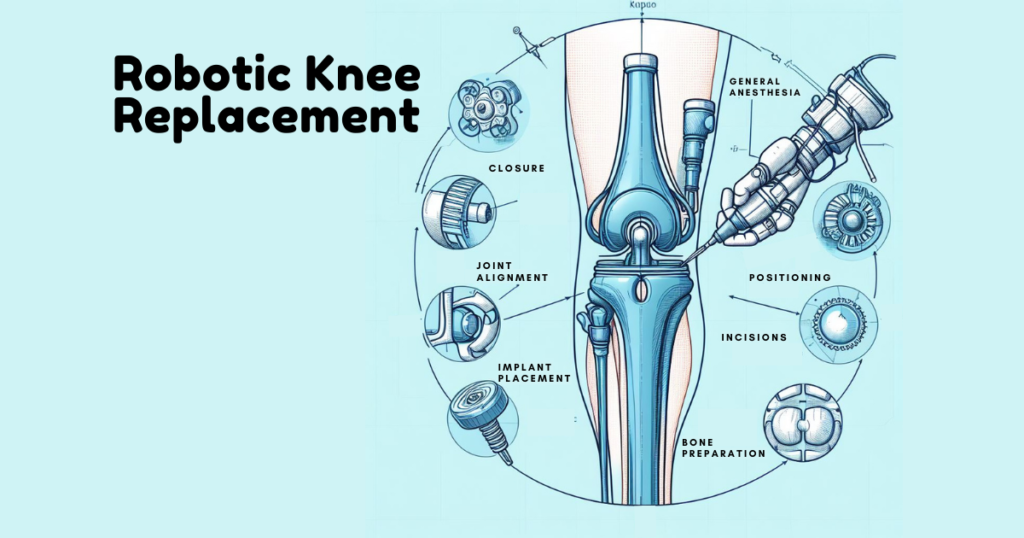Knee pain holding you back? Dive into this Robotic knee replacement surgery guide to understand the procedure, benefits, recovery process, and how to decide if it’s the key to reclaiming your active life. Take control of your knee health today!
The days of invasive, excruciating knee surgeries are gradually fading into the past. A new era of precision and comfort has arrived, spearheaded by the innovative technology of robotic knee replacement surgery.
Robotic knee replacement uses a surgeon-guided robotic arm for precise bone preparation and implant placement, aiming for faster recovery and improved joint function.
Imagine this: a surgeon guiding a robotic arm with unwavering accuracy, meticulously placing and aligning your new knee joint, all while minimizing tissue damage and maximizing your post-operative comfort. This is the reality of robotic knee replacement, a procedure quickly gaining traction thanks to its unparalleled benefits and transformative outcomes.
Gone are the days of large incisions and extensive blood loss associated with traditional knee replacement. Robotic surgery relies on smaller incisions, allowing for a minimally invasive approach that reduces tissue trauma, minimizes blood loss, and translates to faster recovery times and less pain.
But the advantages extend far beyond speed and comfort. The robotic arm, guided by pre-operative 3D imaging and the surgeon’s expertise, operates with unmatched precision. This translates to perfectly aligned knee components, improved joint function and range of motion, and a significantly lower risk of complications.
So, if you’re struggling with debilitating knee pain and considering surgery, it’s time to explore the cutting edge of joint repair. Robotic knee replacement surgery offers a powerful alternative, ushering in a new era of hope and mobility for patients like you.
In the following sections of this guide, we’ll delve deeper into:
- Who is a candidate for robotic knee replacement?
- What to expect during the procedure
- The key benefits compared to traditional surgery
- Recovery and rehabilitation tips
- Important factors to consider
This comprehensive guide will equip you with the knowledge and confidence to make informed decisions about your knee health and explore the potential of robotic surgery to regain your freedom and joy in movement.
Who is a Candidate for Robotic Knee Replacement?
Not everyone with knee pain automatically qualifies for robotic knee replacement. This high-tech procedure is best suited for individuals suffering from advanced stages of knee joint degeneration, where non-surgical measures like medication, physical therapy, or injections have proven ineffective.
The primary conditions that often pave the way for robotic knee replacement include:
- Severe osteoarthritis: This progressive joint disease causes cartilage breakdown, leading to excruciating pain, stiffness, and limited mobility. When conservative treatments fail to provide relief, and daily activities become significantly impacted, robotic knee replacement surgery can offer a lasting solution.
- Rheumatoid arthritis: This autoimmune condition inflames the joint lining, causing swelling, pain, and deformity. In advanced cases, the inflammation can significantly damage the knee joint, warranting surgical intervention.
- Post-traumatic arthritis: Following a severe knee injury, such as a fracture or ligament tear, cartilage damage can occur and gradually develop into arthritis. For individuals with persistent pain and joint instability despite rehabilitation, robotic knee replacement can restore function and alleviate pain.
Determining if robotic surgery is the right fit for you involves a comprehensive evaluation by your orthopedic surgeon. This will typically include:
- Detailed medical history: Understanding your overall health and previous medical conditions is crucial for assessing surgical suitability.
- Physical examination: The surgeon will assess your knee’s range of motion, tenderness, and stability to determine the extent of the damage.
- Imaging tests: X-rays and MRIs provide detailed views of the joint structure and cartilage deterioration, aiding in surgical planning.
- Blood tests: These assess overall health and rule out any potential complications during surgery.
Additionally, factors like your age, activity level, and overall fitness play a role in determining candidacy. Younger, active individuals who lead demanding lifestyles may benefit more from the precise and durable implants used in robotic surgery.
Ultimately, the decision to proceed with robotic knee replacement is a collaborative one, driven by open communication between you and your surgeon. By carefully evaluating your individual needs and considering all options, you can confidently choose the path to a pain-free, mobile future.
In the next section, we’ll delve deeper into the intricacies of the robotic knee replacement procedure itself, exploring the steps involved and the advanced technology powering it.
Navigating the Choice: Exploring Different Types of Knee Replacement
Your journey towards pain-free movement through knee replacement starts with understanding your options. While robotic technology is revolutionizing the field, it’s crucial to be familiar with the different types of knee replacement surgeries available:
1. Total Knee Replacement (TKR):
- The most common type, replacing the entire damaged joint surface with artificial components.
- Suitable for patients with advanced arthritis affecting all three compartments of the knee.
- Offers significant pain relief and improved mobility.
2. Partial Knee Replacement (PKR):
- Replaces only the damaged portion of the knee joint, typically the inner compartment.
- Less invasive than TKR, with potentially faster recovery times.
- Ideal for patients with early to moderate arthritis focused on a single compartment.
- Offers good pain relief and functionality with minimal bone removal.
3. Unicompartmental Knee Arthroplasty (UKA):
- Similar to PKR, this replaces only one compartment of the knee, often the medial (inner) side.
- Highly specialized procedure requiring specific anatomical conditions.
- Offers excellent long-term results for qualified patients, with even faster recovery than PKR.
4. Complex or Revision Knee Replacement:
- Addresses complications or failures from previous knee replacements.
- Requires specialized techniques and implants to address unique challenges.
- Aims to restore joint stability and function after unsuccessful prior surgeries.
5. Patellofemoral Arthroplasty (PFA):
- Focuses solely on replacing the kneecap (patella) and the groove it glides in (femoral trochlea).
- Suitable for patients with isolated arthritis in the patellofemoral joint.
- Minimally invasive, with shorter recovery times than TKR.
6. Robotic-Assisted Knee Replacement (RAKR):
- Utilizes a surgeon-guided robotic arm for precise bone preparation and implant placement.
- Can be applied to any type of knee replacement (TKR, PKR, UKA, etc.).
- Offers potential advantages like increased precision, minimally invasive approach, and faster recovery.
- May not be available everywhere due to cost and limited adoption.
The choice between these options depends on several factors:
- Severity and location of arthritis
- Individual anatomy and bone health
- Previous surgeries and medical history
- Activity level and lifestyle goals
Open communication with your doctor is key. They will assess your specific case and recommend the type of knee replacement best suited to your needs and expectations. This ensures you embark on the journey towards a pain-free future with the most beneficial and lasting solution.
The Key Steps of The Robotic Knee Replacement Surgery

The day of your robotic knee replacement surgery arrives, and with it, a wave of both excitement and apprehension. Knowing what to expect at each stage can alleviate anxiety and pave the way for a smoother experience. So, let’s embark on this journey together, step by step:
Pre-operative Preparation:
- A week before surgery: You’ll undergo routine blood tests, an EKG, and a chest X-ray to ensure your overall health is optimal for the procedure.
- The day before surgery: Discuss anesthesia options with your doctor and stop taking any medications that may interfere with blood clotting. Prepare an overnight bag with comfortable clothes and necessities.
- On the day of surgery: Arrive at the hospital approximately two hours before the scheduled time. Your doctor will review your medical history and anesthesia plan, and answer any last-minute questions you may have.
The Procedure:

- General anesthesia: You’ll be put to sleep to ensure comfort throughout the surgery.
- Positioning: You’ll be positioned comfortably on your back, with your knee secured in a specialized holder.
- Incisions: Your surgeon will make small incisions around your knee joint.
- Bone preparation: Using the robotic arm guided by pre-operative 3D maps, your surgeon will carefully remove the damaged cartilage and bone surfaces.
- Implant placement: Precisely measured and sterilized implants are positioned with the robotic arm’s unwavering accuracy, ensuring perfect alignment and stability.
- Joint alignment: The robotic arm meticulously fine-tunes the positioning of the implants, optimizing joint stability and range of motion.
- Closure: The incisions are carefully closed with stitches or staples.
Recovery:
- Hospital stay: You’ll typically spend one to two nights in the hospital under the care of medical professionals.
- Pain management: Receive medication to manage post-surgical pain effectively.
- Physical therapy: Begin gentle exercises guided by a physiotherapist to promote healing and regain joint mobility.
- Discharge: When your condition stabilizes and you can safely manage stairs and basic activities, you’ll be discharged home with detailed recovery instructions.
Remember: This is a general overview, and your individual experience may vary depending on your specific case and surgeon’s preferences. Don’t hesitate to ask your doctor questions and clarify any concerns you might have along the way.
By understanding the process and preparing yourself mentally and physically, you can approach your robotic knee replacement surgery with confidence and optimism. In the next section, we’ll explore the key benefits this advanced technology offers compared to traditional knee replacement methods.
Benefits of Robotic Knee Replacement
Traditional knee replacement surgery, while a life-changing solution for many, isn’t without its drawbacks. Large incisions, extensive tissue damage, and prolonged recovery times can add a layer of apprehension to the journey. But with the arrival of robotic knee replacement surgery, a new dawn of precision, speed, and comfort has emerged.
Here’s why robotic surgery is setting a new standard for regaining your freedom and joy in movement:
1. Surgical Pinpoint Precision: Imagine your surgeon wielding a scalpel with the unwavering accuracy of a robotic arm. That’s the magic of robotic technology. Guided by pre-operative 3D maps, the robotic arm removes damaged bone and cartilage with near-perfect precision, minimizing unnecessary tissue compromise. This translates to:
- Better implant fit and alignment: Precise placement ensures optimal joint stability and reduces the risk of complications like implant loosening or instability.
- Enhanced joint mechanics: Perfectly aligned components promote natural-feeling movement and improved range of motion.
- Minimized risk of nerve or blood vessel damage: The robotic arm’s delicate maneuvers reduce the chance of injuring surrounding structures, further improving recovery and long-term outcomes.
2. Minimally Invasive Approach: Imagine replacing extensive, open incisions for smaller, keyhole-like portals. The robotic approach relies on these smaller access points, significantly reducing tissue trauma and blood loss compared to traditional surgery. This leads to:
- Faster healing: Less tissue disruption means your body can focus on its natural healing process, leading to a shorter recovery time and quicker return to your daily activities.
- Reduced risk of infection: Smaller incisions minimize the potential entry point for bacteria, lowering the risk of post-operative infections.
- Less scarring: Smaller incisions generally translate to less visible scarring, enhancing your aesthetic outcomes.
3. A Shield Against Pain and Blood Loss: Imagine a surgery where blood loss is minimized and pain management is more effective. Robotic knee replacement utilizes advanced techniques that achieve just that:
- Reduced blood loss: The precise nature of the procedure and smaller incisions contribute to significantly less blood loss compared to traditional surgery. This lowers the risk of needing blood transfusions and associated complications.
- More effective pain management: Minimized tissue damage leads to less post-operative pain. Additionally, robotic surgery allows for targeted pain management techniques, further promoting your comfort.
4. Embracing a Faster Journey Back to Activity: Picture yourself ditching the crutches and regaining your mobility sooner than ever. Robotic knee replacement boasts faster recovery times due to:
- Reduced tissue trauma: Less muscle and surrounding tissue damage translates to quicker healing and less rehabilitation needed.
- Earlier physiotherapy: With less pain and faster healing, you can begin physical therapy exercises sooner, accelerating your progress towards regaining strength and range of motion.
- Shorter hospital stay: Due to the minimally invasive nature and faster recovery, you’ll likely spend less time in the hospital after robotic surgery compared to traditional methods.
5. Unlocking Untapped Potential: Improved Joint Function and Range of Motion: Imagine bending your knee deeper, climbing stairs with ease, and experiencing pain-free movement. Robotic surgery paves the way for:
- Enhanced joint stability: The precise placement of implants and superior alignment lead to a more stable joint, allowing for greater confidence and functionality.
- Increased range of motion: Improved joint mechanics fostered by robotic surgery translate to wider range of motion, enabling you to perform everyday activities with ease.
- Long-lasting results: The precision and stability achieved with robotic surgery contribute to potentially longer implant lifespan and a more durable joint repair.
By embracing the advanced benefits of robotic knee replacement, you can step into a future where pain-free movement and newfound mobility are not just hopes, but tangible realities. In the next section, we’ll explore the recovery process and provide invaluable tips to navigate your journey towards regaining your full potential.
Risks and Complications
While robotic knee replacement offers revolutionary advantages, it’s essential to approach any surgery with an informed mind. Transparency about potential risks and complications empowers you to make confident decisions and navigate your recovery with realistic expectations.
Here’s a look at some potential risks associated with robotic knee replacement, similar to those encountered in traditional surgery:
- Infection: Although minimized due to the minimally invasive approach, there’s still a small risk of infection at the incision site. This typically requires antibiotic treatment and, in rare cases, additional surgery.
- Blood clots: Deep vein thrombosis (DVT) is a risk factor after any surgery, and robotic knee replacement is no exception. Wearing compression stockings and engaging in early mobilization exercises can significantly lower the risk.
- Implant loosening or instability: While rare, implant loosening or instability can occur over time, potentially requiring revision surgery.
- Stiffness or limited range of motion: Post-operative stiffness is manageable through consistent physical therapy exercises. In rare cases, additional procedures might be necessary to improve range of motion.
- Nerve or blood vessel damage: The robotic arm’s precision significantly reduces this risk compared to traditional surgery. However, there’s still a very small possibility of nerve or blood vessel injury during the procedure.
It’s important to remember that these risks are generally rare and often comparable to those associated with traditional knee replacement surgery. Additionally, advances in technology and surgical techniques are constantly improving the safety and efficacy of robotic procedures.
Open communication with your doctor is crucial throughout your journey. Discuss your individual risk factors and any concerns you might have. Additionally, these resources can provide further information about potential risks and complications of robotic knee replacement.
(For more information on potential risks and complications of robotic knee replacement, you can consult resources from the American Academy of Orthopaedic Surgeons, the American College of Surgeons, and the National Institutes of Health.)
By having realistic expectations, educating yourself about potential risks, and maintaining open communication with your doctor, you can confidently navigate the recovery process and embrace the life-changing benefits robotic knee replacement has to offer.
Read Also: AI in Healthcare: New Possibilities in Healthcare
Recovery Tips for a Triumphant Return
You’ve embarked on the journey of robotic knee replacement, and now it’s time to navigate the exciting path of recovery. Remember, this is a partnership between you and your healthcare team, so embrace their guidance and celebrate every milestone along the way. Here are some invaluable tips to ensure a smooth and successful journey back to your fullest potential:
Physical Therapy and Rehabilitation Exercises:
- Embrace the Power of Physio: This is your new mantra! Regular physical therapy is crucial for regaining strength, flexibility, and range of motion in your new knee. Your therapist will design a personalized exercise program tailored to your specific needs and progress.
- Start Small, Achieve Big: Don’t be intimidated by complex exercises. Begin with gentle movements like leg lifts and ankle pumps, gradually progressing to activities that mimic your daily routines. Consistency is key – small, regular efforts lead to significant gains over time.
- Listen to Your Body: While pushing yourself is part of the process, respect your body’s limitations. If you experience pain, discomfort, or swelling, slow down and inform your therapist. Recovery is a marathon, not a sprint, so pace yourself and celebrate every step of the way.
Pain Management Strategies:
- Medication Marvels: Your doctor will prescribe pain medication to manage post-operative discomfort. Follow the instructions carefully and don’t hesitate to reach out if the pain feels beyond manageable. Remember, proper pain management allows you to participate in physical therapy more effectively and facilitates faster recovery.
- Ice is Your Ally: Cold therapy reduces inflammation and promotes healing. Apply ice packs to your knee for 15-20 minutes at a time, several times a day. Remember to never place ice directly on your skin – a towel barrier is your best friend.
- Elevating Elevation: Keeping your knee elevated above your heart level helps reduce swelling and promotes drainage. Invest in comfortable pillows or specialized wedges to elevate your knee while resting or sleeping.
Returning to Daily Activities:
- The Gradual Climb Back: Start small – ditch the crutches when you feel confident, reintroduce simple tasks like showering and cooking, and gradually build up to activities you enjoy. Walking short distances will become easier over time, and soon you’ll be tackling stairs and conquering daily routines with your newly empowered knee.
- Listen to Your Doctor: Don’t rush the process. Your doctor will provide a timeline for resuming specific activities based on your individual progress. Trust their expertise and avoid pushing yourself too hard, as it can hinder your recovery.
- Embrace Support: Don’t be afraid to lean on your loved ones for help during this time. Delegate tasks, accept assistance, and allow yourself to focus on your recovery. Remember, a supportive network is your strength and can significantly influence your emotional and physical well-being.
By following these tips, maintaining clear communication with your healthcare team, and embracing a positive mindset, you can navigate the recovery process with confidence and emerge stronger and more mobile than ever before. As you regain your strength and rediscover your freedom of movement, remember that this journey is a testament to your courage and resilience. Celebrate every milestone, big or small, and bask in the joy of reclaiming your active life.
The Conclusion of Your Journey
Robotic knee replacement surgery isn’t just a procedure; it’s a gateway to a future brimming with newfound mobility and pain-free movement. We explored the revolutionary advances this technology offers, unveiling a world where:
- Unwavering precision: The robotic arm guides your surgeon with unparalleled accuracy, ensuring optimal implant placement and improved joint mechanics.
- Minimally invasive approach: Smaller incisions translate to faster healing, less blood loss, and reduced risk of infection, paving the way for a smoother recovery.
- Faster return to activity: Embrace shorter hospital stays, quicker rehabilitation, and a faster journey back to the activities you love.
- Enhanced joint function and range of motion: Experience improved stability, wider range of motion, and long-lasting results for a truly transformative experience.
But remember, choosing the right path for your knee health is a personal decision. While robotic surgery presents a groundbreaking option, explore all avenues and consult with a qualified orthopedic surgeon. Discuss your individual needs, understand your options, and determine if robotic surgery is the key that unlocks your future of pain-free movement.
Take the first step toward a brighter future. Research further, consult with your doctor, and embrace the empowering possibilities that robotic knee replacement surgery offers. Remember, knowledge is your guiding light on this journey, and informed decisions pave the way to a life filled with mobility, joy, and endless possibilities.



































